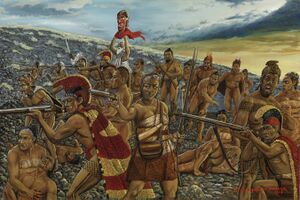Kalean Rebellion of 1703: Difference between revisions
No edit summary |
No edit summary |
||
| Line 22: | Line 22: | ||
| combatants_header = | | combatants_header = | ||
| combatant1 = [[Kingdom of Mokupuni]] | | combatant1 = [[Kingdom of Mokupuni]] | ||
{{flag|Kalea Confederation}}[[Kalea Confederation|Kalea]] | |||
| combatant2 = Revolution Forces | | combatant2 = Revolution Forces | ||
| combatant3 = | | combatant3 = | ||
Revision as of 04:05, 18 June 2023
| Kalean Rebellion of 1703 | |||||||
|---|---|---|---|---|---|---|---|
 Armed citizens partaking in the rebellion. | |||||||
| |||||||
| Belligerents | |||||||
| Template:Country data Kalea ConfederationKalea | Revolution Forces | ||||||
| Strength | |||||||
| 25,000 | 15,500 | ||||||
| Casualties and losses | |||||||
|
7,800 dead 5,600 wounded |
6,700 dead 5,100 wounded | ||||||
The Kalean Rebellion of 1703 was a civil conflict between the various castes of Kalean society. It began in early May 1703 and continued till late November 1703. The conflict was fought primarily over religious and cultural factors amidst the greatest societal change in Kalean history.
Background
Kalea had been undergoing a religious, spiritual, and cultural revolution for almost a century and saw the abandonment of traditional beliefs following the founding of Pūlahism and Koaism in which the idea of a caste-based society was seen as wrong. The upper castes maintained the traditional Kalean beliefs and saw any new ones as kapu ("forbidden") and brought it before the monarchy where such beliefs were outlawed. Harsh punishments were carried out on any who were seen openly practicing any other beliefs. Those who were caught were given the opportunity to recant any new beliefs and proclaim their belief in the old ways. If they did, they were banished despite doing so. For those that refused, they were put to death immediately.
Rebellion
These punishments came to blow after the monarchy executed an entire village for refusing to recant their beliefs. They were all carried out by hanging. Afterwards, travelers from a nearby village who had come to meet with friends saw the scene, which would later be called the Hoomana Massacre. They buried the bodies of every villager, which was estimated to be around 150, before returning to their village to let others know. Word spread of the massacre, turning even many in support of the caste-system against the monarchy and upper castes.
In early May 1703, several dozen Kaleans were to be put to death for not recanting their beliefs, but before they were executed roughly one hundred villagers rescued them from the executioners, instead killing them. In the weeks to follow, this same occurrence would happen again and again in village after village. The monarchy conscripted more men to put a stop to it but were met with even more opposition. The independent villages began to march together with men and women up in arms to stop their friends and family from being murdered. Eventually, both sides in this conflict formed larger units to put an end to either side. Fighting would continue for months until in late November 1703 King Nālani agreed to stop fighting and listen to the people.
Aftermath
After fighting had stopped, the caste system that had existed in Kalea since its first settlers arrived was officially abolished by King Nālani. With the abolition of the caste system, Kalean women were granted greater freedom and equality.